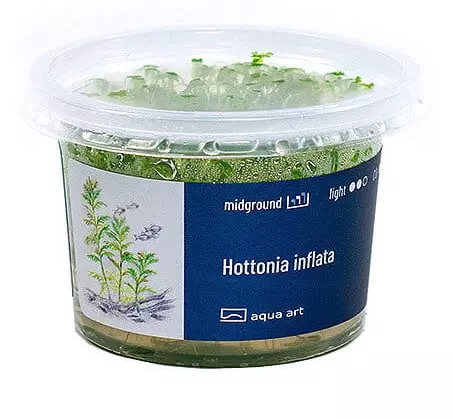Hottonia Inflata (Nasturtium Hottonia) is a low-maintenance, secondary plant. It is characterized by branching stems with alternate pinnate, light green leaves.
- Difficulty of growing: easy
- Light requirements: medium
- CO₂ requirements: medium
- Height of adult plant: up to 40 cm
- Growth rate: fast
- Temperature: 18-26°C
- Placement in aquarium: Second level
- Origin: North America
- Shell diameter: 6 cm
Hottonia Inflata (Nasturtium Hottonia, Nasturtium Columbine) is a relatively easy to grow stem plant. It is intended for the second or third tier of plants in the aquarium. Its natural range is central and eastern North America. It grows in wetlands where it overgrows shallow, still waters such as swamps and ponds. It prefers moderate, moist climates without extreme temperatures and acidic water, but can tolerate neutral water.
In nature, seeds germinate in shallow waters in fall or winter. The young plants are protected from low temperatures by water. As they grow, the stem expands until it reaches the water table. When the temperature rises, the plant forms the characteristic flower stalks with which it floats on the water surface.
The flowers appear by late spring or summer. The plant produces numerous seeds that float on the water surface for a short time. They then sink to the muddy bottom of the pool where they germinate or go dormant for a year. After the seeds are released, the plant dies. Therefore, it should be cut back regularly in the aquarium.
Hottonia inflata has branched stems from which alternate elongated, pinnate, light green leaves emerge. It is prized by aquarists for its unique appearance, ease of cultivation and rapid growth. In aquariums, the plant is propagated vegetatively by lateral regrowth or by cutting off the tips and planting them in the substrate. After pruning, it spreads and forms dense clumps.
It does not require CO₂ fertilization, but its administration significantly accelerates growth. Like other plants, it needs liquid fertilizers so that it can absorb nutrients from the water column (nitrogen compounds, potassium, phosphates, iron, magnesium). It grows best in an active substrate; if the substrate is poor, it is advisable to add additional fertilizer directly under the roots.
Planting: The plant must be removed from the cup and thoroughly rinsed from the gel under running water. This is best done by placing the plant in a container of lukewarm water. Most of the gel will then fall off by itself. Divide the contents of the cup into 1-2 cm lumps and then place them at a small distance on the selected items
.











.jpg)










